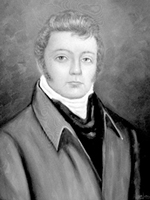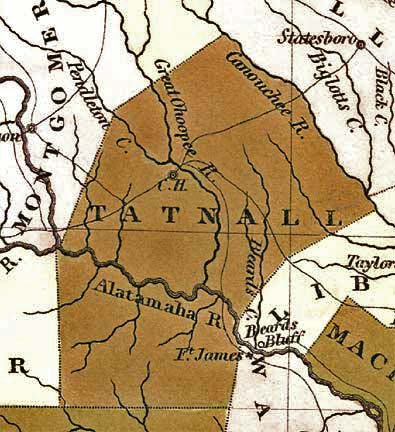Judge Robert Raymond Reid – The Man for Whom Reidsville was Named
By Gordon A. (Tony) Thompson
One of the few portraits of Judge Robert Raymond Reid (1789-1841). Courtesy Florida State Library and Archives.
One of the most respected of all the Judges to serve South Georgia and particularly the Tattnall Superior Court was Judge Robert Raymond Reid. He served as a Superior Court circuit judge for Tattnall County from 1816 through 1818 until he was elected to fill a vacancy in the U.S. Congress in 1819. He was subsequently reelected to two more terms in Congress. In 1823 and 1824 Reid served as Mayor of Augusta then was reappointed as circuit judge of the Middle District for Georgia in 1825. Reid so impressed the people of Tattnall County that when the courthouse and county seat was moved from the Ohoopee Saw Mills to the geographic center of the county, the new town was named Reidsville in his honor. Reid may have visited the town named for him but his service to Tattnall County’s Superior Court was conducted entirely at the first county seat at Ohoopee Saw Mills village on the Ohoopee River.
1822 Map Showing Tattnall’s Courthouse along the Ohoopee River
before the Town of Reidsville was founded in 1832. Courtesy Carl Vinson Institute.
The same year Reidsville was created in 1832, Reid moved to Florida and took the position of Judge of the Superior Court of the Eastern Territory of Florida. Florida was not yet a state but was moving rapidly in that direction. Reid’s migration to Florida was partly the result of a broken heart. His beloved wife Eliza Randolph Reid had recently passed away and the grief-struck widower thought new surroundings would help him recover from his moribund state of mind. He was about 43 years old when he moved to Florida. His duties took him on regular travels between Tallahassee, St. Augustine and Jacksonville. Having come from the Georgia frontier, he was probably used to the long days travel between courthouses and indeed his diary tells that he often made camp along the way and ate his supper over a campfire.
When he was in his home, he made regular entries into his journal and from those scribblings we learn a great deal about his character.
He typically arose before dawn, spent some time doing daily devotionals, dressed, read newspapers and then took on the day’s business. On the 27th of May in 1833 he described waking at six in the morning, then read some from the book of Revelations, “about the witnesses, the candlesticks, the olive trees before the throne, the Great Beast from the bottomless pit and the sounding of the seventh trumpet.” He then prayed and “schemed his mind of the transactions of the day”. Afterwards he dressed then wrote an “epitome of the aforesaid chapters in Revelations”. It was his custom to write a summary or “epitome” as he called it, of many things he read. After writing he had breakfast, then “drew his daughter’s attention to several interesting tales and paragraphs” he saw in the daily newspapers. Then he was off on some errands. He stopped in on two or three clients, a Methodist preacher named Elliot, whom he noted was a graduate of Athens. Then he visited another judge and his wife. After that he stopped by a store and purchased some “gaitors” to ward off mosquitoes, which he described as “intolerable at night.” Then he passed on to the Episcopal Chapel and later stopped in a shoe shop and ordered some boots for his daughters to “keep off the infernal mosquitoes”. After returning home he “distributed candy to the children” and noted the “thermometer at 80, the hour at 12.” In his journal for that day, he says he “resolved to turn over a new leaf—to be more busy, useful, better!” His day was only just begun as he typically worked until 8 p.m. and did not retire until well past 10 p.m. or later.
His entries tell us he was a man in pursuit of bettering his physical health. And from his oft-mentioned bouts with “melancholy”, we can guess he thought his mental health would also be improved by keeping his affairs orderly and busy.
On June 6th of 1833 he wrote out a “Scheme of Life for June”.
Rise at 5 or 6 a.m.
Devotions and business to 7.
Dress, newspapers and breakfast to 8.
Newspapers, exercise, calls business to 3 p.m.
Dinner, rest, light reading to 6.
On Monday- Law
Tuesday- History
Wednesday- Composition
Thursday- Law
Friday- History
Saturday- Composition
Pleasures and Recreations:
Reading
Writing
Playing at Chess
Conversation
Wine and water at dinner
Toddy after 9 at night
Two segars at the same time
Exercise
Business- Official duties to be first performed. Private business next.
Lose no opportunity of instructing and enlightening my children.
Be just and impartial, and temperate
Kind, frank and obliging.
God Help Me!
Like many of us today, he suffered no shortage of new “resolutions” to adjust his life, though his seem to come monthly rather than annually. In August of 1833 he again listed some suggestions to guide him. Following some sleepless nights and bouts with headaches he wrote “Tis no use – I must come to it at last, and now I do most seriously and finally resolve to change my life.”
He resolved, “I will only indulge in stimulants at or just before dinner, nor will I smoke more than one or two segars (sic), and those after 10’oclock at night.
Pleasures must come to me. Eat no suppers, slight breakfasts and moderate dinners.
Exercise by walking or riding horseback.
Use aperients (mild laxatives). Make myself, if possible, agreeable to all, both black and white; mind my own business. Do what I can to promote the happiness of those around me. Pray and serve God.”
Perhaps Reid’s resolutions paid off because he did on to greater successes. He gained accolades and fame in Florida, just as he had in Georgia. He served as president of the Constitutional Convention for the territory of Florida in 1838 and he served as the Territorial governor of Florida from 1839 to 1941. He also found happiness again in his romantic life and married a young native Georgia girl who was destined to become noteworthy in her own right. But that, as they say, is a story for another day.
Sources:
The Tattnall County, Georgia, Superior Court Records 1805-1832
Robert Reid’s Journals, of the Manuscripts Collections at UNC Chapel Hill, N.C.
Biographies of U.S. Congressmen, Library of Congress
Portrait of Reid image courtesy Florida State Library and Archives
1822 Map of Tattnall County image courtesy of the Carl Vinson Institute of Government, UGA
For more historical accounts of old Tattnall County visit www.kinfolksacrosstheriver.com


